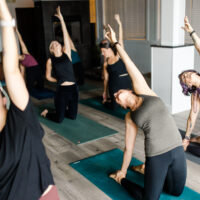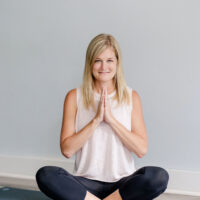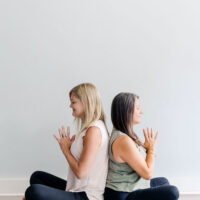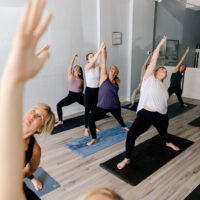Yoga Off the Mat: Ahimsa (Non-Violence, Non-Harming)
Behind the physical postures, there are many more layers to yoga – a deep ocean rich with wisdom, traditions and practices to help guide us in our journey to living a happy and healthy life. While the physical practice of yoga is by and large the gateway for most people, over time with a consistent yoga practice, you begin to learn (and feel) there is something more to it; something beyond downward facing dog and pigeon pose. There is a subtle wisdom with which this form of physical movement is delivered and it is this subtle wisdom that separates yoga from most other forms of fitness and what has helped this practice thrive for thousands of years.
In the traditional yoga texts, a wise sage named Patanjali mapped out a yoga “system” for optimal living. As part of that system, he developed 2 philosophical branches – the yamas and the niyamas – to serve as an ethical framework for how we can best interact with ourselves and the world around us. While this philosophy is powerful in and of itself, when combined with our physical and/or meditation practices, we are able to put the philosophy into action in our own bodies and minds – strengthening our presence and joy and reducing our stress and suffering.
Origin
The word yama translates into “restraint” and the yamas are an ethical framework to help us cultivate happiness in our inner and outer worlds and move us toward a state of wholeness. The 5 yamas, together with the 5 niyamas, are a significant part of the yoga philosophy, helping to give us a road map for effective living.
The first yama, Ahimsa, comes from two Sanskrit words – “a” meaning “not” & “himsa” meaning “harm”. In the Yoga Sutras, Patanjali says that we are to actively practice nonharming as the foundation of the whole yoga practice – essentially saying that if we can master this one thing of nonharming, we will master the practice of yoga and ultimately the goal of living well.
Intention
The yogis believe there is no higher virtue than to do no harm. This goes beyond the obvious gross acts of violence such as physical assault. Violence can and often takes the form of many more subtle acts such as selfishness, anger, judgment and negativity. Ahimsa asks us to embrace nonviolence at the level of thought, speech and action and this requires us to cultivate a deep awareness of our actions and thoughts.
If we are being honest with ourselves, we can all admit that we have angry, violent and negative thoughts daily. These can be about ourselves, such as looking in the mirror and criticizing our appearance, and they can be critical thoughts and words about others. Even when we have these thoughts, we can still perceive everything to be fine because we usually don’t act upon them. However, if we are committed to personal evolution, then we must align our thoughts, actions and words; knowing that our thoughts are the foundation for all of our relations with the world outside of us.
The work of nonharming begins with us. It is said 95% of our emotions are determined by how we talk to ourselves. The biggest question we have in yoga then is “what are we feeding?”
Practices to Put Nonharming in Action On the Mat…
–Be aware of self-criticism in a posture; when it arises, return focus to the breath or replace the critical thought with a grateful thought
-Be kind through honoring physical boundaries, giving yourself the gift of rest, and when needed, practicing doing less and being more
-Smile and embrace light heartedness and laughter, especially in the challenging moments
-Remember the physical practice is a powerful tool for liberating harmful emotions locked in our body’s tissues; when tension or struggle arises, remain steady in breath and find areas in the body where you can soften and surrender
Practices to Put Nonharming in Action Off the Mat…
-Keep continued awareness of critical and judgmental thoughts of yourself and others
-Treat your body well through good nourishment, rest and self-care practices; while spreading ourselves thin may seem impressive, we are the first to lose
-Remember the ripple effect – your words and actions have the potential to affect everyone and everything around you; one unkind word or gesture can ruin someone’s day, which can impact everyone else they come into contact with
-Practice the Power of the Pause: before you react to a situation, take a deep breath to connect back to the present moment and respond from a place of compassion and love
-Meditate daily to observe the quality of your thoughts; add in the meditation of compassion to water the seeds of love and acceptance inside yourself
-Instead of asking “What’s in it for me?”, ask “How can I be helpful?”
-When making a decision, put it through the 4 question filter: Does it harm me? my family? my community? my planet?
-When your mind wanders to a negative place, flip the script with a mantra such as “I am peace”
Wise Words…
“If we want to change the way that we interact with the world, then we have to change our words and actions by changing our thoughts.” -Judith Lasater, Living Your Yoga
“Violence in any form is a tragic expression of our unmet needs.” -Marshall Rosenberg, Non-Violent Communication
“If you want to end darkness, you cannot beat it with a baseball bat, you have to turn on a light.” -Marianne Williamson, A Return to Love
“The belief that it is possible to heal the world without healing ourselves first is what the Yoga Sutras call a lack of true knowledge. The truth is, when we are happy, we spread happiness, and when we are in pain, we spread suffering.” -Rolf Gates, Meditations from the Mat
“Happiness comes when your work and words are of benefit to yourself and others.” -Buddha
If you want to explore the yamas deeper, check out my online Embodying Yoga Philosophy Series where you’ll be guided through 5 full length practices centered around each of the 5 yamas. Enroll here.
Alissa Rodgers, eRYT500, is a Columbus, OH based yoga and meditation teacher and the founder and co-owner of GoYoga. She’s been practicing yoga for over 16 years and within the past 5 years, has shifted her practice toward exploring the philosophy and mindfulness aspects of yoga on a deeper basis. This has positively impacted her life in many ways and it’s a true gift to get to share these powerful tools of yoga with others! View her in person and livestream teaching schedule here.





